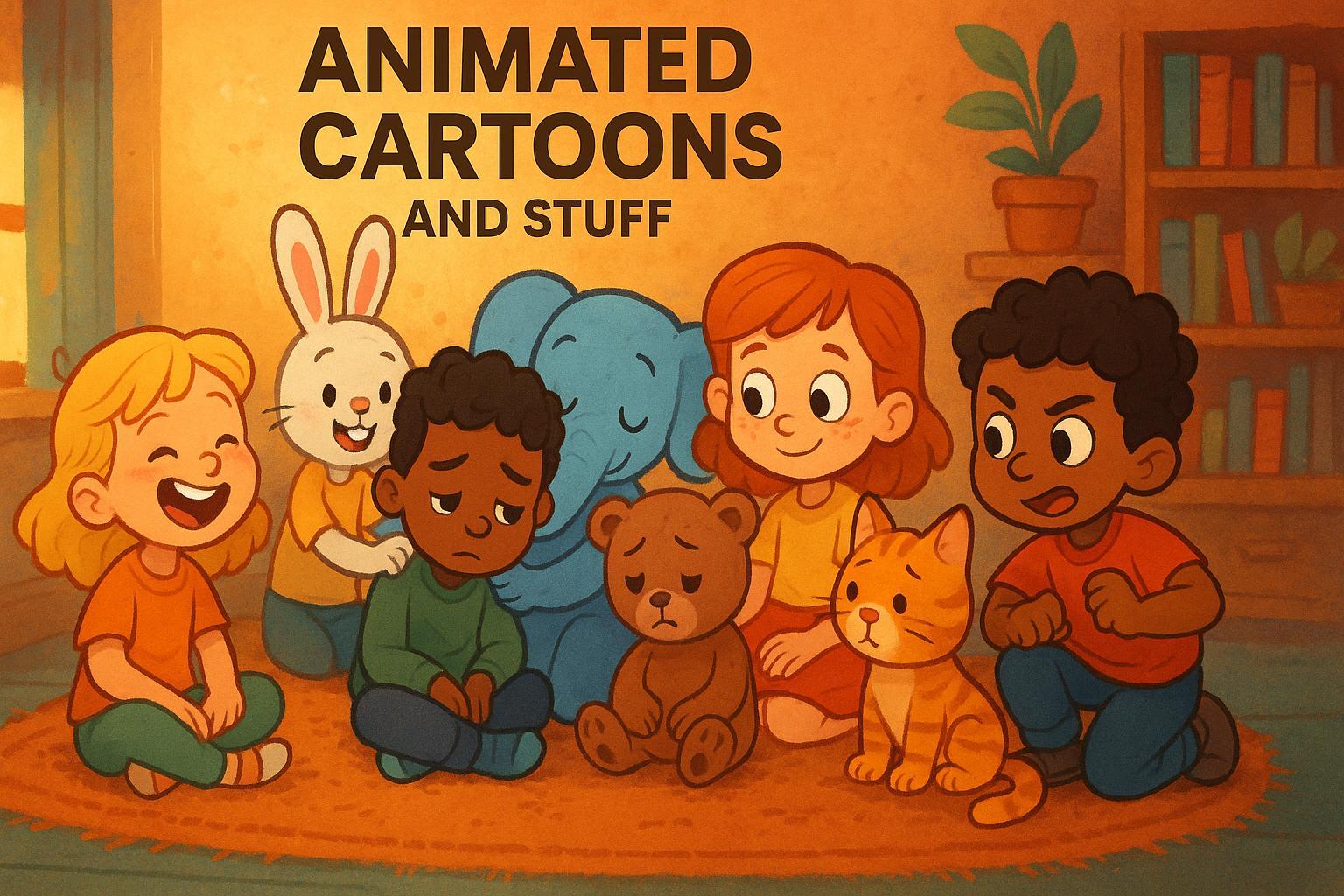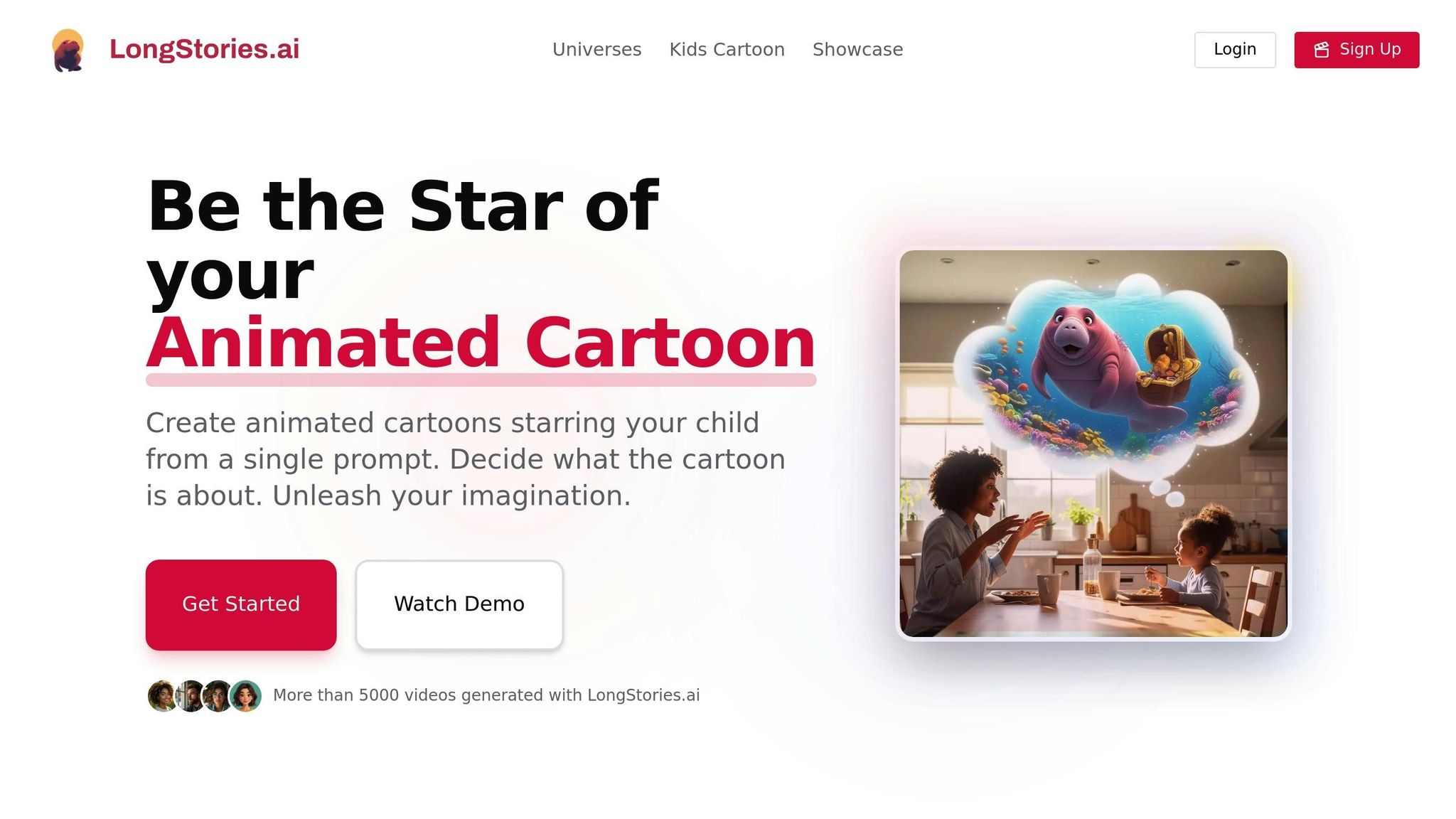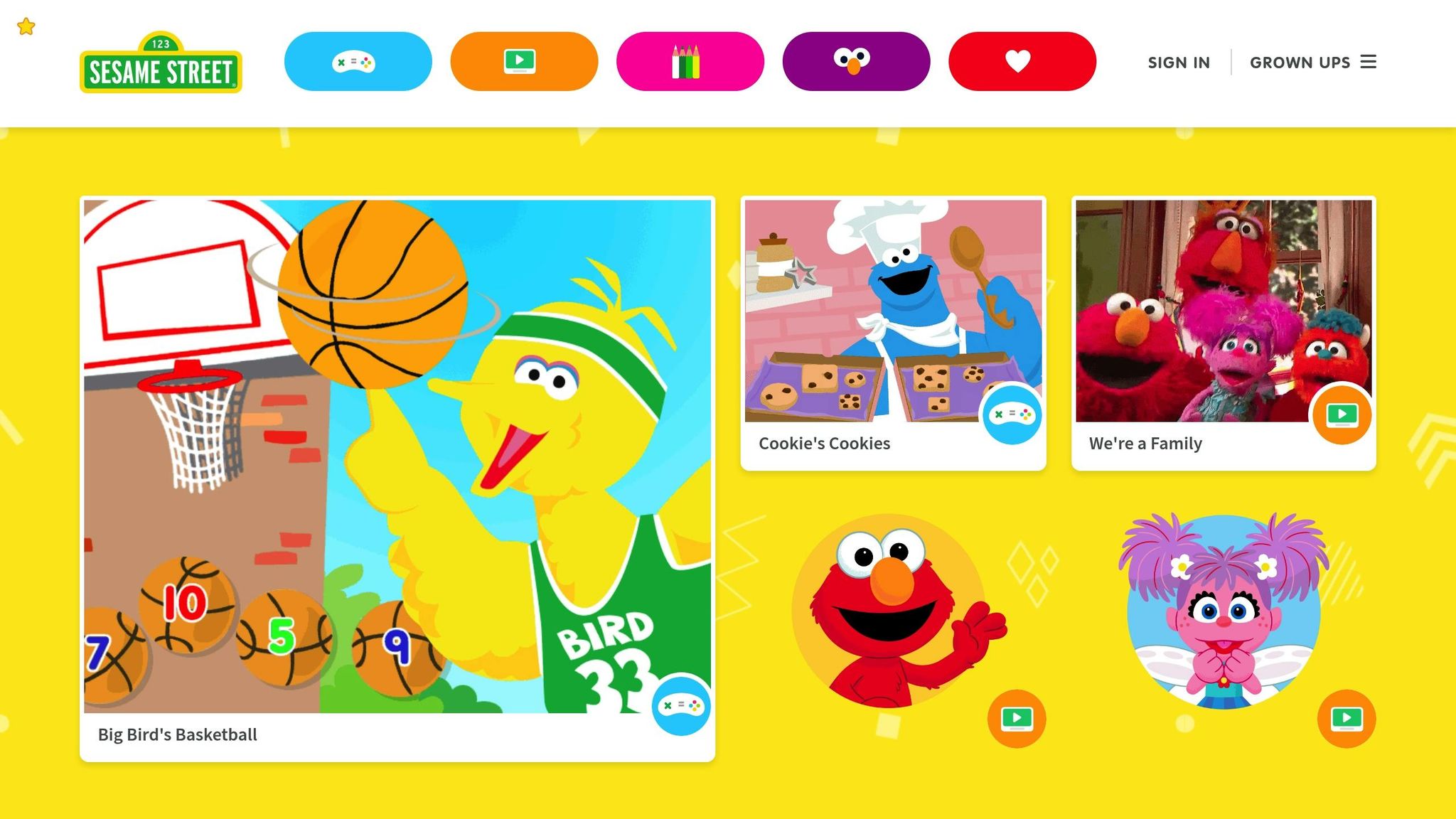
LongStories is constantly evolving as it finds its product-market fit. Features, pricing, and offerings are continuously being refined and updated. The information in this blog post reflects our understanding at the time of writing. Please always check LongStories.ai for the latest information about our products, features, and pricing, or contact us directly for the most current details.
10 Animated Stories That Teach Emotional Skills
Animated stories are more than just fun - they help kids learn emotional skills like empathy, kindness, and resilience. Here's why they work:
- Relatable Characters: Kids connect with characters facing challenges similar to their own.
- Emotional Vocabulary: Stories introduce new ways to express feelings and understand others.
- Healthy Coping Strategies: Characters model positive ways to deal with emotions like anger, sadness, or frustration.
- Memorable Lessons: The mix of visuals, narration, and emotions makes these lessons stick.
- Diversity: Stories often include characters from various backgrounds, promoting inclusiveness.
Some great examples include Inside Out, Daniel Tiger's Neighborhood, and The Rainbow Fish. These animations teach kids how to understand their feelings, build relationships, and grow emotionally - all while keeping them entertained.
Alfred & Shadow - A short story about emotions (education psychology health animation)
How We Chose These Animated Stories
We carefully selected animations that teach kids about emotions, relationships, and personal growth. Here's a breakdown of the criteria we used to guide our choices.
Stories That Teach Emotional Skills
Our top priority was emotional depth. Each animation had to address key skills like empathy, kindness, resilience, and self-awareness. We focused on stories where characters face real challenges and demonstrate healthy ways to cope.
To engage young viewers, we emphasized relatable characters and storylines. It was important that these characters showed emotional maturity while also recognizing their own strengths and imperfections.
Research highlights that animated characters who model effective emotional control and constructive responses to stress can teach kids how to manage their own emotions. We chose stories where characters actively demonstrate positive behaviors instead of simply talking about them.
Content Suitable for Children
Ensuring the content was age-appropriate was just as important. We selected stories tailored to the cognitive and emotional needs of children aged 3–12.
"Understanding the visual preferences of different age groups plays a crucial role in the success of an animation." - Michelle Connolly, Educational Voice
We also prioritized diversity. Stories featuring characters and cultures from various backgrounds were important to promote understanding and inclusiveness. This is particularly relevant given that racial and ethnic minorities make up nearly half of the under-5 age group in the U.S..
Additionally, we evaluated how well each story used clear, concise language and whether it could hold a child’s attention. The animation style had to be visually engaging, using colors and sound effects to enhance emotional resonance.
Learning Through Entertainment
The best learning happens when it doesn’t feel like learning. We selected stories that align with Wonder Media’s philosophy:
"The motivating animated stories are designed so children will stumble into learning while they enjoy each teaching exercise." - Wonder Media
Studies show that animated stories improve understanding, retention, and engagement.
We focused on animations that use visual storytelling to make lessons memorable. By combining words with images, these stories help children better understand emotional concepts. The dynamic nature of animation captures attention, boosts motivation, and aids in processing information - all of which are essential for building empathy and awareness.
Each story also had to showcase social interactions, such as teamwork, disagreements, or collaboration. These scenarios help kids learn about relationships and how to resolve conflicts. We also looked for stories that encourage self-reflection, helping children explore their own emotions and reactions.
Finally, we assessed how well each animation balanced entertainment with emotional development. The result? A curated collection of stories that engage, educate, and support emotional growth .
5 Animated Stories That Teach Emotional Skills
These animated tales are more than just entertainment - they're tools for kids to explore emotions, relationships, and personal growth. Each story brings its own unique lessons, packaged in a way that keeps children captivated and learning.
LongStories.ai Personalized Adventures

LongStories.ai takes storytelling to a whole new level by letting kids star in their own animated adventures. With just a simple text prompt, this platform creates fully voiced animated stories in under a minute. Since its launch, it has crafted over 5,000 personalized tales that help kids tackle emotional challenges. Featuring AI characters like Manny the Manatee and Professor Time, these adventures guide children through relatable scenarios, teaching them empathy, resilience, and problem-solving. Up next, let’s dive into a classic tale that uses an underwater world to teach the value of kindness.
The Rainbow Fish
This timeless story, brought to life through animation, teaches kids about the joy of sharing and the importance of kindness. The journey follows a stunningly beautiful fish who learns that giving to others brings more happiness than keeping everything for himself. With its vibrant underwater scenes, the story keeps kids glued while delivering a powerful message. Watching the fish transform from proud and isolated to generous and beloved highlights how sharing fosters meaningful connections and personal growth.
Inside Out (Shorts and Clips)
Pixar’s Inside Out doesn’t just entertain - it teaches kids how emotions work together. Through short clips and segments, emotions like Joy, Sadness, and Anger are personified, making complex ideas easy to grasp.
"Inside Out shows how each emotion has its purpose and contributes to a person's overall well-being. It encourages children to recognize and articulate their emotions, fostering empathy by helping them see how emotions influence actions and decisions".
These animations help kids understand that all emotions - even the tricky ones like sadness or anger - are important. They learn to embrace their feelings as part of a balanced emotional life.
Sesame Street Animated Segments

For decades, Sesame Street has been helping kids navigate everyday emotional challenges through its animated segments. Whether it’s learning to share toys, dealing with frustration, or making new friends, these stories provide clear visuals and simple language to connect with young viewers. By offering practical solutions, they give kids tools they can use in real life, all while keeping the lessons fun and relatable.
Daniel Tiger's Neighborhood Animated Stories
Inspired by the legacy of Mister Rogers, Daniel Tiger's Neighborhood tackles common emotional struggles with warmth and care. Each episode features catchy songs and phrases that kids can easily remember and apply, teaching them strategies to handle feelings like fear, sadness, or frustration. Watching Daniel Tiger and his friends model healthy ways to cope shows kids that strong emotions are normal - and manageable. Research from Pace University even highlights how storytelling can effectively teach emotional intelligence to preschoolers. These stories blend engaging characters with practical lessons, helping kids build empathy, confidence, and social skills.
sbb-itb-94859ad
How Animated Stories Help Children Learn About Emotions
Animated stories act as a stepping stone for young minds, using relatable characters, engaging techniques, and real-world scenarios to teach emotional coping skills. Here’s how these elements come together.
Characters and Situations Kids Relate To
Animated characters often connect with children in ways live-action ones might not. Their simplified designs and clear expressions make it easier for kids to relate and empathize. Since about 90% of the information our brains process is visual, animated videos become a powerful tool for teaching empathy.
Through exaggerated facial expressions and body language, cartoons vividly portray emotions. For instance, a character with slumped shoulders and a frown makes sadness instantly recognizable. Shows like Arthur or Peppa Pig reflect everyday situations, helping kids see that emotions like frustration, embarrassment, or empathy are perfectly normal.
Showing Healthy Emotional Responses
The best animated stories don’t just show emotions - they demonstrate positive ways to handle them. When characters pause to take deep breaths during stressful moments or share their worries with a friend, they’re modeling practical strategies kids can adopt.
Elements like color, lighting, music, and sound effects enhance the storytelling, making emotions easier to understand. For example, films like Pixar’s Inside Out go a step further by personifying emotions, showing that every feeling serves a purpose and that it’s okay to experience a mix of them.
By tackling challenges head-on, animated characters normalize emotional struggles. Watching their favorite characters manage fears or anxieties can help kids feel less isolated and remind them that everyone faces tough moments.
Sparking Conversations and Activities
Animated stories also open the door for meaningful conversations about emotions. They give parents and kids a chance to discuss feelings and approach tricky situations with empathy. For example, pausing a story to ask, “How do you think the character feels?” or “What would you do here?” encourages kids to reflect on their own experiences.
Research from Pace University highlights how storytelling can teach preschoolers emotional intelligence skills. When kids discuss why characters act the way they do, they expand their emotional vocabulary and become more self-aware.
Hands-on activities can deepen these lessons. Drawing emotions, acting out alternative endings, or sharing personal stories all help reinforce what kids learn. Early exposure to these discussions is crucial, as many emotional challenges in adulthood stem from gaps in childhood understanding. Using animated stories as a starting point, parents and educators can help kids build emotional skills that will serve them for life.
Conclusion: Using Animation to Help Children Grow Emotionally
Animated stories play a powerful role in helping children build emotional skills, which are crucial for both social and academic success later in life. Research highlights these benefits, showing that quality programming can make a lasting impression.
For example, nearly 75% of teenagers remember emotional lessons from watching Daniel Tiger's Neighborhood. Even more striking, 57% of teens said their most memorable takeaways involved learning how to understand and manage emotions.
However, passive viewing isn’t enough. As Eric Rasmussen explains:
"It's not enough to just plop your kid in front of the TV and hope they're going to develop these social and emotional skills. There has to be a certain level of involvement in kids' TV viewing experiences."
To make the most of animated stories, choose programs that showcase a variety of characters, cultures, and emotions, focusing on themes like kindness, resilience, and empathy. Stories that address challenging topics can be especially impactful, offering valuable lessons that stick with children.
Animation has a unique ability to simplify complex ideas while forging emotional connections. Relatable characters help children absorb and retain these lessons effectively. Whether it's a well-loved series or a customized story from LongStories.ai, the goal remains the same: to equip children with the emotional intelligence they need to grow and succeed.
FAQs
How do animated stories help children build emotional skills in ways traditional storytelling doesn’t?
Animated stories have a way of drawing children in that traditional storytelling often struggles to match. With their bright visuals, expressive characters, and lively soundtracks, these tales grab kids' attention and create an emotional connection to the narrative. This kind of immersive experience helps children better understand and relate to the emotions and challenges the characters face.
What makes animated stories stand out is how they break down complex emotional ideas into relatable, visual moments. For instance, when kids see characters expressing emotions like sadness, joy, or determination, it helps them recognize and process these feelings in their own lives. On top of that, many animated stories weave in lessons about problem-solving and resolving conflicts, offering kids practical examples of how to handle their emotions and interact with others.
What should parents look for in animated stories that help teach emotional skills to kids?
When selecting animated stories to help children grow emotionally, it’s important to keep a few things in mind. Start by choosing stories with relatable characters who navigate emotional challenges and learn from them. This connection helps kids better understand their own feelings and develop empathy. Look for stories with engaging themes like kindness, resilience, or friendship, as these can leave a lasting impression and encourage emotional growth.
The visual and audio quality also plays a big role. Bright, well-crafted animations and appealing soundtracks can capture a child’s attention and make the story stick in their memory. Lastly, always check that the content is age-appropriate - it should match your child’s developmental stage to ensure it’s both enjoyable and meaningful.
Can animated stories help children develop emotional intelligence, or do parents need to get involved for the best results?
Animated stories are a fantastic way to help children understand and navigate their emotions. With relatable characters and situations, these stories make it easier for kids to grasp concepts like empathy, kindness, and resilience. They can illustrate how different emotions interact or demonstrate ways to face challenges, simplifying what might otherwise feel overwhelming or confusing.
But here’s the thing - parental involvement can take this experience to the next level. Watching alongside your child or having a conversation about the story afterward can strengthen their understanding and help them connect what they’ve seen to their own lives. Asking questions like, “How do you think that character felt?” or “What would you have done in that situation?” transforms a casual viewing into a valuable learning moment.
